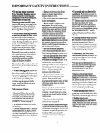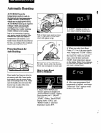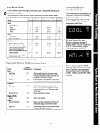
. Foods with unbrokenouter
%kin” such as potatoes,sausages,
tomatoes, apples, chicken livers
and other giblets, and egg yolks
(see previous caution) should be
pierced to allow
steam to escape
during cooking.
● PlasticUtensils-Plastic utensils
designed for microwavecooking are
very usefid, but should
be used
carefully.Even microwaveplastic
may not be as tolerant of
overcooking conditions as are
glass or ceramic materials and
may soften or char if subjected to
short periods of overcooking.In
longer exposures to overcooking,
the food and utensilscould ignite.
For these reasons: 1)Use
microwaveplastics only and use
them in strict compliance with
the utensil manufacturer’s
recommendations. 2) Do not
~, subject empty utensils to
IL+:microwaving.3) Do not permit
children to use plastic utensils
without complete supervision.
. “Boilable”
cooking pouches
and tightly closed plastic bags
should be slit, pierced or vented
as directed in cookbook. If they
are not, plastic could burst during
or immediately after cooking,
possibly resulting in injury. Also,
plastic storage containers should
beat least partially uncovered
because they form a tight seal.
When cooking with containers
tightly coveredwith plastic wrap,
removecoveringcarefi.dlyand&t
steam awayfrom hands and face.
● Foodscooked in liquids (such
as pasta) may tend to boil over
more rapidlythan fti containing
less moisture. Should this occur,
reikrto page40 for instructionson
howto clean the insideof the oven.
=.”’
● Spontaneousboiling—Under
certainspecialcircumstances,
liquidsmaystarttoboil duringor
shortlyafterremovalfromthe
microwaveoven.Topreventbums
from splashing liquid, stir the
liquid briefly beforeremovingthe
containerfrom the micmwaveoven.
● Use of the DO~LE DUTIPM
shelf accessory.
—Remove the shelf from oven
when not in use.
–Do not store or cook with shelf
on floor of oven. Product damage
may result.
–Use pot holders when handling
the shelf and utensils. They may
be hot.
–Do not use microwavebrowning
dish on shelf. The shelf
could
overheat. Use of shelf with
Automatic Cooking feature is not
recommended.
Lower Oven:
c
Stand awayfrom the oven
when opening ovendoor. The
hot air or steam which escapes
can cause burns to hands, face
and/or eyes.
● Don’theat unopened food
containersin the oven. Pressure
couldbuild upandthe container
could burst, causing an injury.
s
Keep oven vent ducts
unobstructed.
● Keep oven free from grease
buildup.
c Place oven rack in desired
position while oven is cool. If
racks must be handled when hot,
do not let potholder contact
heating units in the oven.
c Pulling out shelf to the shelf stop
is a convenience in lifting heavy
foods. It is also a precaution
● When using cooking or roasting
bags in oven, followthe
manufacturer’sdirections.
● Do not use your ovento dry
newspapers.
If overheated, they
can catch fire.
Self Cleaning Lower Oven:
. Do not clean door gasket. The
door gasketis essentialfor a good
seal. Care should be taken not to
rub, damage or movethe gasket.
c
Do not use oven cleaners. No
commercial oven cleaner or oven
linerprotectivecoatingof any kind
should be used in or around any
part of the oven.
c Clean only parts listed in this
Use and Care Book.
● Before self-cleaning the oven,
removebroilerpanandother
utensils.
. Listen for fan—a fan noise
should be heard sometime during
the cleaning cycle. If not, call
for
servicebeforeself-cleaningagain.
SAW THESE
INSTRUCTIONS
against burns from touching hot
surfacesofthe door or ovenwalls.
5


















